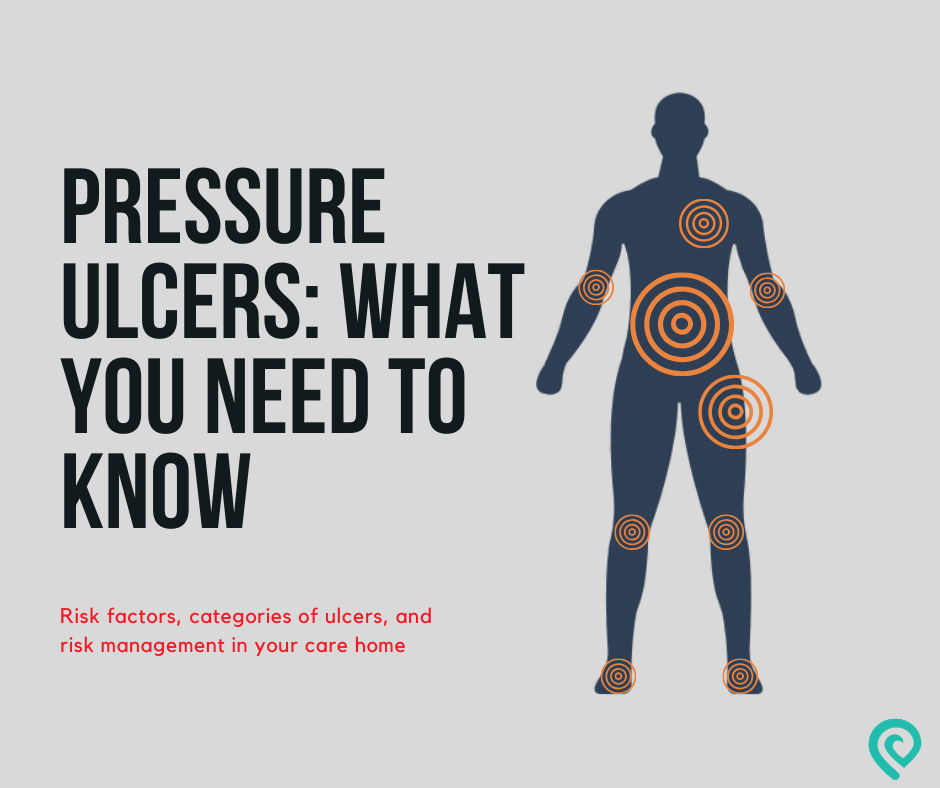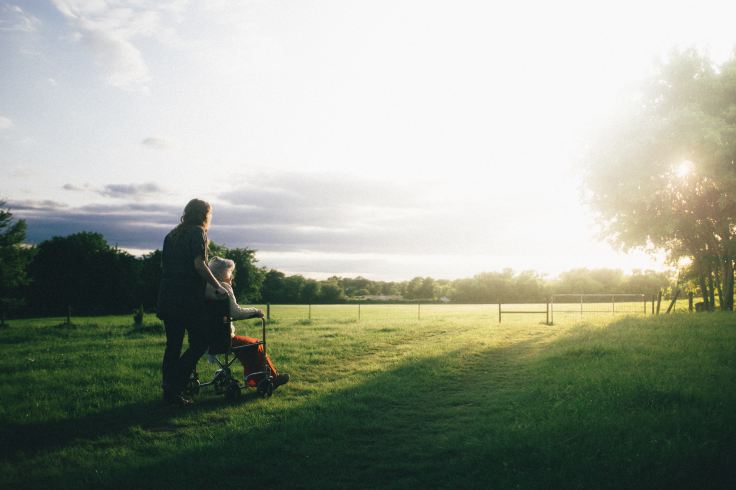
Pressure ulcers, also known as bedsores or pressure sores, happen when pressure is applied to the same area of skin for a longer period of time cutting off blood supply. This results in damage to the skin, as well as damage to tissue under the skin. A pressure ulcer is more likely to occur when a person is bed ridden, or has to stay in a sitting position for a long time. When the constant pressure on a part of the body shuts down the blood vessels feeding that area of the skin, that is when you get a pressure ulcer. This is why it’s so important to re-position those residents who are confined to their chairs or beds for longer periods of time.
Vulnerable areas which are prone to pressure ulcers are the lower back, buttocks, shoulders, hips, knees, heels, and ankles. Think of it this way, if a person is likely to lie down or sit on a body part, or if the body part protrudes (like shoulders or hips), there is a higher chance that pressure will be applied to that spot most often. It’s important to consistently re-position, and keep a watchful eye for any potential pressure injury risk, since without care these injuries can become very serious.
Pressure sores can cause pain, and furthermore can badly damage the bone and muscle underneath the skin. They can also take a very long time to heal.
Categories of Pressure Ulcers
There are a few categories of pressure ulcers which are similar to degrees of a burn. A category 2 pressure ulcer looks like an open wound or a blister which generally affects the top layer of the skin . A deeper wound which reaches secondary layers of skin is classified as a category 3 pressure ulcer. Lastly, and most damaging is a category 4 pressure ulcer, which is a wound that might reach the muscle and bone.
If a pressure ulcer is considered a category 3 or 4, these are serious wounds with full skin and tissue loss and are something that should be reported to the CQC.
If you’re in the process of healing a pressure wound, here are some tips to prevent further injury, and promote a recovery:
• Speeding up the healing process and helping to relieve pressure can be done by applying special dressings
• Re-positioning up to every 2 hours. When you move and change position regularly you’re promoting blood flow to the damaged area to promote healing and recovery, as well as allowing airflow to the area.
• Provide special mattresses and cushions to provide a constant flow of air.
• Providing a healthy diet
• Keep hydrated
• Clean the wound and remove damaged tissue.
Remember, most pressure ulcers are preventable and are a result of neglect. Whether this is a neglect of re-positioning the resident with a wound, a lack of proper treatment for the wound, a neglect of good diet and hydration, or not using the right equipment to help with healing and personal relief, it’s plain and simple: Neglect. This is why a care home manager must report this to the CQC as serious neglect.
Some Residents are At Higher Risk for Pressure Ulcers

As a care home manager you should have the ultimate oversight of all of the residents in your care home. Although it’s a fact that all care or nursing home residents are at a slightly higher risk of developing pressure sores than the rest of the general population, there are those within the care home resident population that are a significantly higher risk than most. Keep tabs on those high risk residents and make it a habit to follow-up with nurses and carers within your facility, as well as chatting with the resident themselves to ensure that the best possible care is being provided.
What are the High Risk Factors to Developing Pressure Sores?
Restricted movement or mobility is probably the most obvious risk in this case when it comes to developing pressure ulcers, however other things may also indicate higher risk in a resident. Having had a previous pressure ulcer, any current sores, skin that is dry and weak, poor nutrition, dehydration, and loss of sensation in parts of the body are all contributing factors to developing pressure ulcers.
Managing Risk of Pressure Ulcers in a Residential Care Home
In a nursing home, a registered Nurse should complete a risk assessment of every resident that moves into the home within 6 hours of their arrival. In nursing homes, and specialist care homes there are usually nurses readily available on staff, but if you run a residential care home you might not have a registered nurse handy at all times.
If a resident moving into a care home has the risk of developing a pressure ulcer, they should be referred to a community nurse. The nurse should be advised that the resident needs a risk assessment on the first visit, as well as a detailed care plan for the staff employed at the care home. The case might also be, depending on where the home is located and which local authority is responsible for providing nursing care, that a district nurse will come in person to the care home and tend to the resident to give clinical care as needed. If a resident has been living at your care home for a while, and has developed a risk for pressure ulcers, get in touch with your care home GP so he or she can connect you to community nurse services in your local area.
Note: Each local authority has their own referral practice. Make sure that you have the right contact details and process in your care home protocol. This protocol will explain the step by step process of how and when to make a referral if there is concern about pressure ulcers developing.
Looking for qualified, vetted, and experienced carers for your care home? Take a look at the MyWorkMode platform to gain access to your own virtual on-demand bank team.
